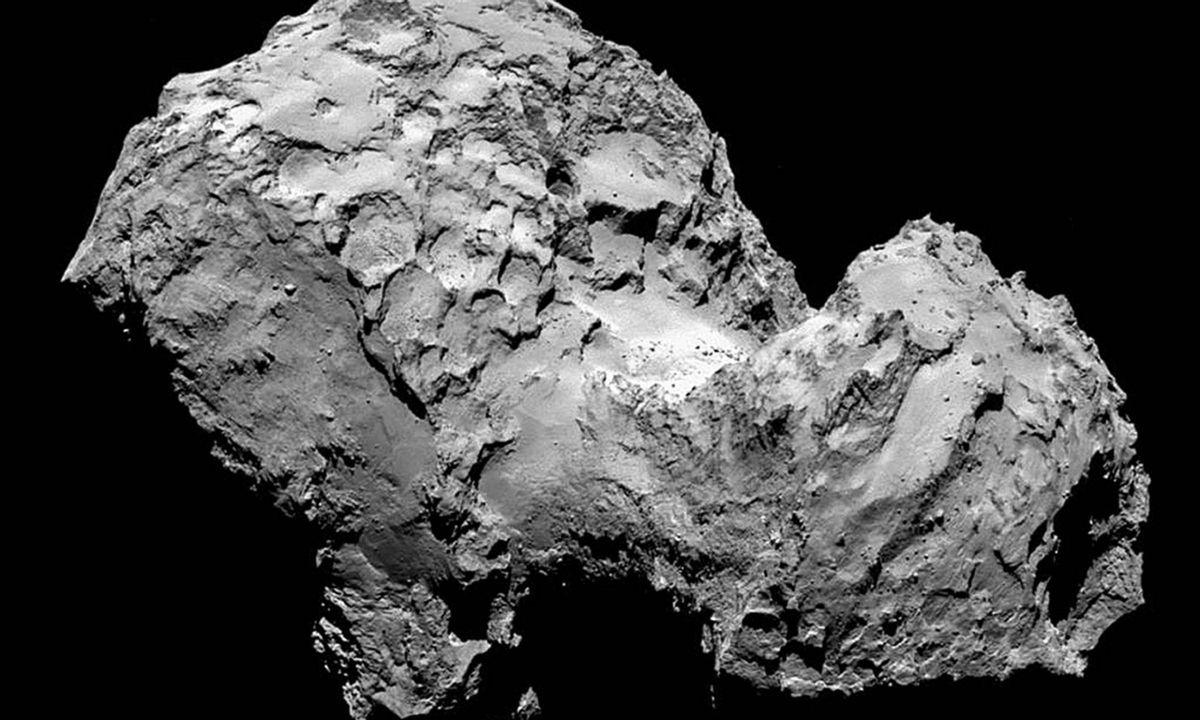NEWS: Two scientists have suggested that Comet 67P could harbor a form of alien life.
In July 2015, two astronomers proposed a rather surprising explanation for some of the peculiar physical properties exhibited by a comet identified as Comet 67P — alien life:
The comet has a black hydrocarbon crust overlaying ice, smooth icy “seas” and flat-bottomed craters containing lakes of re-frozen water overlain with organic debris.
Prof Chandra Wickramasinghe said data coming from the comet seems to point to “micro-organisms being involved in the formation of the icy structures, the preponderance of aromatic hydrocarbons, and the very dark surface”.
“These are not easily explained in terms of prebiotic chemistry. The dark material is being constantly replenished as it is boiled off by heat from the sun. Something must be doing that at a fairly prolific rate.”
“Five hundred years ago it was a struggle to have people accept that the Earth was not the center of the universe," Wickramasinghe said. "After that revolution our thinking has remained Earth-centered in relation to life and biology. It's deeply ingrained in our scientific culture and it will take a lot of evidence to kick it over."
This news was reported by media outlets such as Time magazine and the Guardian, but it isn't the case that the University of Buckingham's Chandra Wickramisinghe and his colleague, Dr. Max Wallis, have proved that comet 67p actually harbors a form of alien life. The scientists merely offered a theory based on unverified data, and as Forbes observed, for example, Wickramisinghe's theories have a number of potential flaws to them:
[T]he first problem with Wallis’ and Wickramasinghe’s claim [is]: organic molecules are very common in the Solar System and beyond, without any need for living things to make them.
The second problem is that we know comets are active bodies. The most famous feature of a comet is its twin tails of gas and dust, which are created when the Sun bombards it with light and the particles known as the solar wind. This bombardment heats the comet’s surface and knocks material loose. The potholes and jets the Rosetta probe sees forming on the surface of Comet 67P are almost certainly due to that process, not the presence of life under the ice.
The third problem is that one of the researchers, Wickramasinghe, sees life everywhere he looks. His was the false claim several years ago that a Martian meteorite contained diatoms — single-celled plant life. He has also claimed that SARS came from space. To put it mildly, we should take any of his claims about life in the Solar System with enough salt to fill the ocean on Uranus.
Phil Plait, author of the Bad Astronomy blog on Slate, has also taken issue with Wickramisinghe's research methods. In 2013, after the astronomer claimed to have discovered life on a meteorite, Plait described the flaws in Wickramisinghe's methods:
In a nutshell, they don’t establish the samples they examined were actually meteorites. They don’t establish they were from the claimed meteor event over Sri Lanka in December 2012. And perhaps most telling, they don’t eliminate the possibility of contamination; that is, diatoms got into the samples because those rocks were sitting on the Earth where diatoms are everywhere.
There’s more, too, including some unusual methods if you’re trying to establish a paradigm-overthrowing claim: They don’t consult with outside experts (including those in the fields of meteorites and diatoms), they don’t get independent confirmation from an outside lab, and they published in a journal that is, um, somewhat outside the mainstream of science.
Wickramasinghe is a proponent of the idea of panspermia: the notion that life originated in space and was brought to Earth via meteorites. It’s an interesting idea and not without some merits. However, Wickramasinghe is fervent proponent of it. Like, really fervent. So much so that he attributes everything to life in space. He’s said that the flu comes from space. He’s said SARS comes from space. He’s claimed living cells found in the stratosphere come from space.
Philae and Rosetta, the two spacecrafts studying the comet, are not equipped to search for extraterrestrial life forms:
Philae made history on 12 November 2014 when it landed on the speeding comet, marking the culmination of a 10-year, 4-billion-mile journey to the comet by hitching a ride with the Rosetta spacecraft.
The solar-powered lander lost contact with Earth on Nov. 15 — 60 hours after it landed on the speeding comet, bounced and came to a final resting place in a shady area lacking the necessary sunlight to keep the lander alive.
As the comet got closer to the sun, Philae awoke [in June 2015] and sent an 85-second transmission to Earth.
